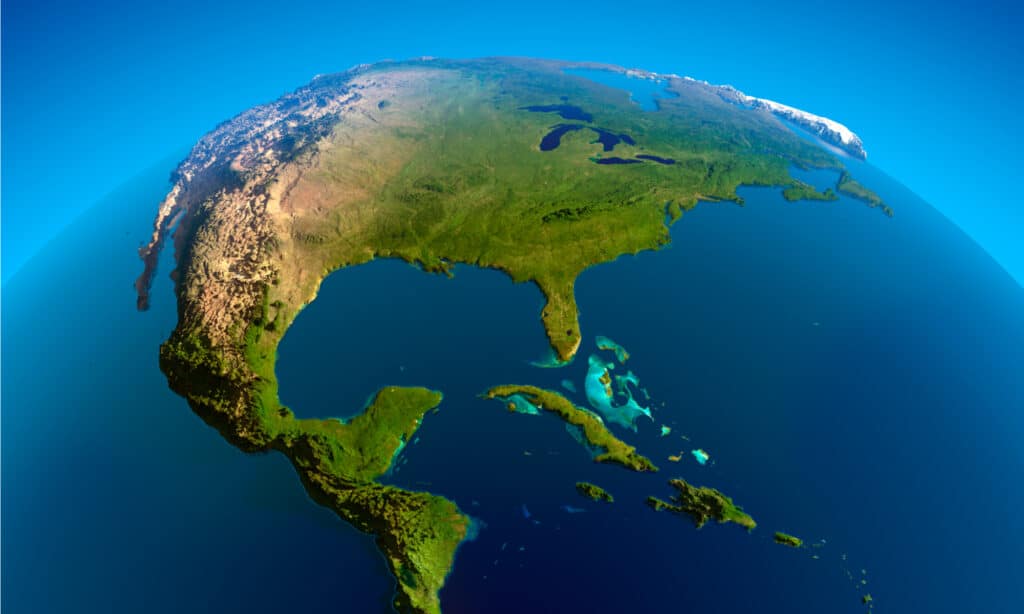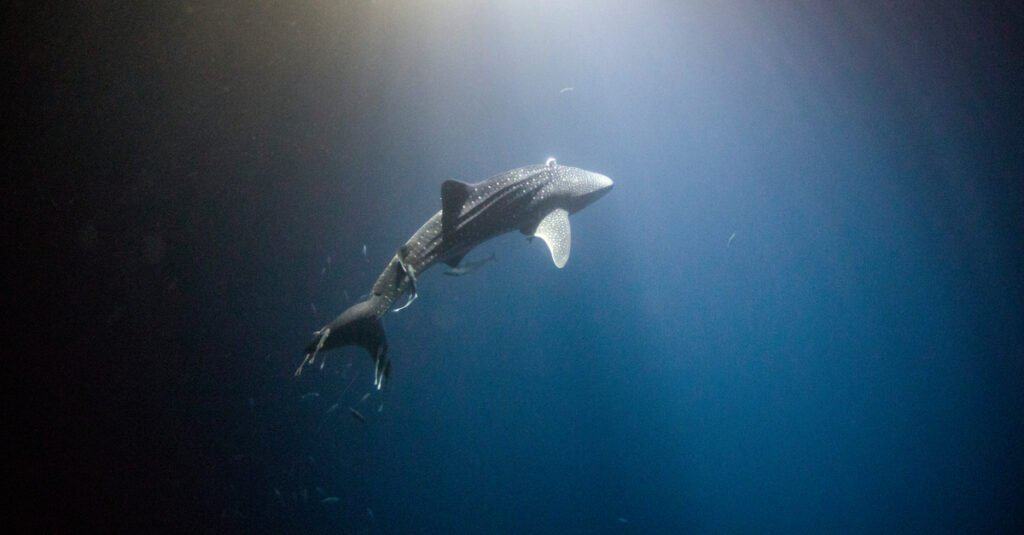The Gulf of Mexico is massive and home to many large fish and mammal species. The largest fish found in the Gulf of Mexico is impressive and beautiful, the whale shark. These whale sharks are breathtaking and massive. Despite their size though, they are gentle giants and don’t pose a threat to humans. Keep reading to discover the biggest fish found in the Gulf of Mexico and fun facts about it.

About the Gulf of Mexico
The Gulf of Mexico is a large ocean basin surrounding Mexico, Cuba, parts of the U.S., and some Mexican states. Interestingly, the Gulf of Mexico first took shape over 300 million years ago. It is 930 miles wide and oval-shaped. The surface area of the Gulf of Mexico is 600,000 square miles, while the average depth is 5,299. The deepest point in the Gulf of Mexico is the Sigsbee Deep, which is between 12,303 and 14,383 feet deep.

View of the Gulf of Mexico from space.
©Anton Balazh/Shutterstock.com
How Many Fish Live in the Gulf of Mexico
The Gulf of Mexico is massive and home to many different animal species, including fish. There are about 1443 finfish, 51 sharks, and 49 species of rays and skates. Some of the more common fish living in the Gulf of Mexico are the king mackerel, mutton snapper, red snapper, red grouper, and the Spanish mackerel. The Gulf of Mexico is a popular body of water for fishing. It offers anglers opportunities to catch rainbow trout, swordfish, and mahi-mahi.

The Gulf of Mexico is a popular body of water for fishing.
©Coastal Girl/Shutterstock.com
The Biggest Fish Found in the Gulf of Mexico
Surprisingly, the largest fish in the Gulf of Mexico, isn’t just a fish, but a shark as well. Whale sharks are the largest fish found in the Gulf of Mexico. Whale sharks are most common in northern parts of the Gulf of Mexico. They are docile sharks, and despite being named whale sharks, are not related to whales. These elegant fish live in deep water and are hard to spot. It’s not ever guaranteed you will swim or see a whale shark up close, but you have the best chance of spotting them in Mexico, Belize, Australia, and Tanzania.

Whale sharks are the largest fish found in the Gulf of Mexico.
©Katja Tsvetkova/Shutterstock.com
About Whale Sharks
Whale sharks are beautiful, slow-moving fish. They are massive and found almost everywhere in the world. Their conservation status is threatened. They were first caught and recorded in April 1828 when a whale shark was harpooned in Table Bay, South Africa. A year later, Andrew Smith described the whale shark in detail. These large fish have long lives. Scientists estimate that most whale sharks live between 80 to 130 years.
Size and Appearance
Whale sharks are massive and unique. They are easy to spot and distinguish from other sharks because of their large open mouths and flat bodies. They swim slowly and gracefully and have white spots and stripes on the top of their bodies. Their bellies are white and they have thick and rough skin, despite looking smooth. Whale sharks grow up to 61 feet long. However, most whale sharks reach 48 feet long. Their mouths are also very wide. For instance, a 39.7-foot whale shark has a mouth size of 5.1 feet. This is the height of some fully grown adult humans!
Diet
These large sharks aren’t picky eaters. They also don’t hunt for food like other predatory sharks, instead, they are filter feeders. There are only three filter-feeder shark species including the basking shark and the megamouth shark. Whale sharks mainly eat plankton, fish, squid, and eggs. They eat by opening their mouths wide and swimming slowly. Sometimes, they suck in deeply, which pulls prey right into their mouths. While whale sharks aren’t aggressive, they are smart. They have been recorded waiting for the right time, before feeding on mass spawning of fish shoals. To keep up with their size, whale sharks eat a lot. A young juvenile whale shark eats about 46 pounds of plankton each day.

Squid are part of the diet of a whale shark.
©iStock.com/Gerald Corsi
Predators
Whale sharks don’t have to worry about most predators. Because of their size, they aren’t targets of whales, sharks, or other large sea animals. Instead, only young juvenile whale sharks are hunted by blue marlins, great white sharks, and blue sharks, but it’s rare. The biggest threat to whale sharks is humans. Whale shark meat and liver oil are highly sought after in some countries, which has led to their threatened conservation status.

Only young juvenile whale sharks are hunted by blue marlins, great white sharks, and blue sharks, but it’s rare.
©Lindsey Lu/Shutterstock.com
The Largest Whale Shark Ever Recorded
The largest whale shark ever recorded was an impressive 61.7 feet. These large sharks easily weigh up to 21.2 tons. Although this is the largest record so far, it doesn’t mean it’s the maximum size a whale shark can grow up to. There is still a lot that we, and scientists don’t know about this majestic and massive shark.
The photo featured at the top of this post is © Rainer Lesniewski/Shutterstock.com
FAQs (Frequently Asked Questions)
Where is the Gulf of Mexico?
The Gulf of Mexico is a large ocean basin surrounding Mexico, Cuba, parts of the U.S., and some Mexican states.
What is the largest fish found in the Gulf of Mexico?
The largest fish found in the Gulf of Mexico is impressive and beautiful, the whale shark. These whale sharks are breathtaking and massive. Despite their size though, they are gentle giants and don’t pose a threat to humans.
Thank you for reading! Have some feedback for us? Contact the AZ Animals editorial team.







